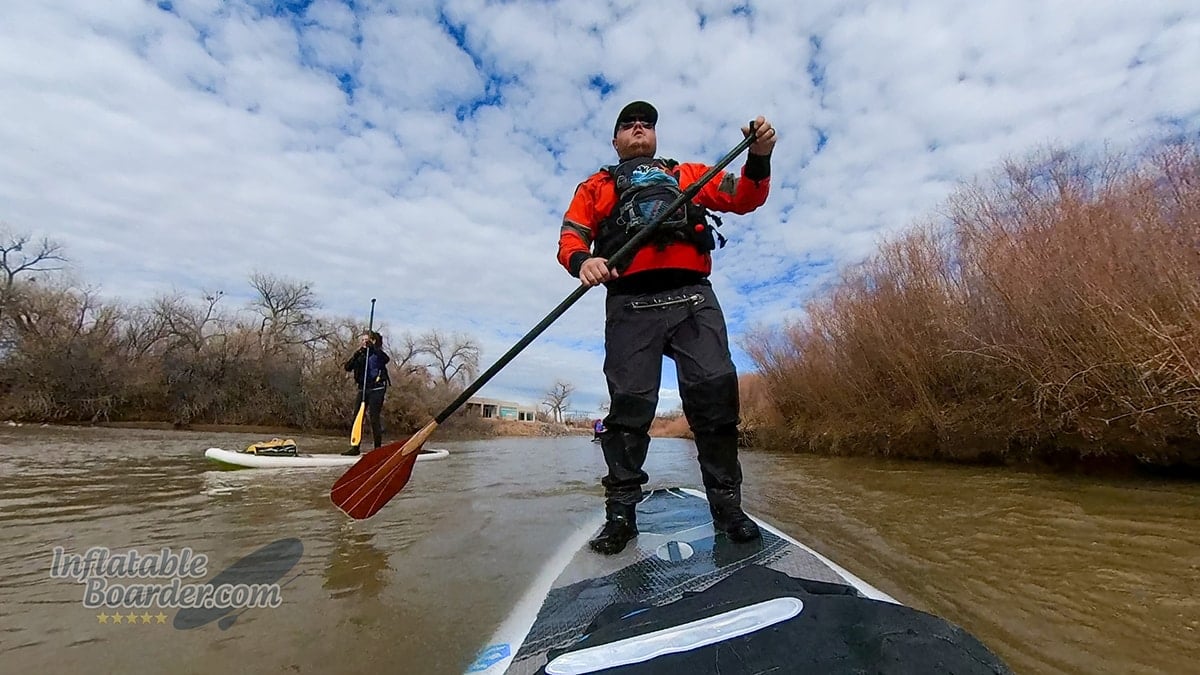
Just because the temperature starts to drop doesn’t mean you have to put your paddleboard away for the season. Here is an in-depth guide for how to safely enjoy winter paddling.
Stand Up Paddleboarding doesn’t have to stop when the temperatures start to drop. Paddling in the winter opens up great opportunities to continue exploring, watch wildlife, and maintain fitness routines. Winter paddling can feel like a whole new sport in some cases, and there are definitely important pieces of equipment you need to have (as well as other considerations to make) in order to have a fun and safe time on the water.
I’m going to start this guide with information about Cold Water Safety and the Hazards of Cold Water. I’m not doing this in order to scare anyone away from paddling in the winter, but rather to have a frank and open conversation about Cold Water and the very real concerns that exist. The second part of the guide is about Clothing for winter paddling, and the last part is about additional Equipment and Tips for winter paddling.
Cold Water Safety
When getting started and geared-up for winter paddling it’s important to understand the conditions you’ll be paddling in and what safety concerns those bring. One of the best resources available about staying safe in cold water is the Vancouver, Washington based non-profit National Center for Cold Water Safety. Their mission is to “reduce the incidence of close calls, injuries, and fatalities due to cold water immersion” through the study and promotion of cold water safety.
I highly recommend you take a half hour out of your day, cozy up with a cup of hot chocolate, and read through their website: coldwatersafety.org. There is so much excellent information available on this website about cold water dangers, mitigation, equipment, case studies, myth busting, and more. In the next few sections I’m going to go over a few key take-aways here, but again, it’s worth taking the time to read through their website for more information.
What is Cold?
Cold Water is not the same as Cold Air.
Without diving into a physics lesson that I’m definitely not qualified to teach, the simple difference between Water temperatures and Air temperatures is that Water is approximately 20 times (2000%) more efficient at transferring heat than air. When we are gearing up for winter paddling, our primary concern for thermal safety is going to be the Water temperature.
Statistically, the most dangerous water temperatures are between 50-60°F (10-15°C). These water temperatures don’t seem to be that cold, and they are commonly encountered when air temperatures are moderate. Many coastal areas may even encounter these water temperatures year-round, but even in the heat of summer this is still cold water.
These mild-seeming water temperatures can lure paddlers into becoming complacent about cold water safety, especially on warm days, but they are still cold enough to trigger a Cold Shock response in your body – especially if you are not acclimated to cold water.
At what temperatures do we need to begin thinking about Cold Water safety?
The answer is probably going to surprise you. Water is considered “cold” temperatures are 70°F (21°C) or lower. This doesn’t mean you need to grab a full-blown dry suit with layers of fleece, neoprene hood, and gloves, but you do need to begin dressing for thermal safety.
Myth Busted: When I began paddling I was told to add the air and water temperatures together, and if it’s greater than 120°F (49°C) then you don’t need to worry about dressing warm. This is absolutely a myth and should not be used. By this method, a 70°F (21°C) air temperature and 50°F (10°C) water temperature wouldn’t have any concern for cold water safety. Except, as mentioned previously, those water temperatures can be extremely dangerous.
Cold Shock
Cold Shock is a physiological reaction your body undergoes when suddenly immersed in Cold Water. This can happen in water temperatures much warmer than expected, even occurring in water as warm as 60°F (15°C). We prevent cold shock by dressing appropriately, however it is important to know what happens if you or someone else is unprepared for immersion.
Cold Shock manifests in many ways, and they are all extremely dangerous.
Involuntary Gasping is an uncontrollable response where you take in large breaths of air through your mouth. This can be a single breath or multiple. The immediate concern is if one or more of these gasps happens while your mouth is underwater. This can cause immediate drowning. Continued gasping can cause hyperventilation (bringing its own physiological concerns) and additional chances to breathe water into your lungs (gradual drowning or flush drowning). Once you have inhaled water it also becomes harder and harder to float at or to the surface if you are not wearing a PFD (life jacket). This is why many Cold Shock victims seem to fall into the water and just disappear. Always wear your PFD.
Hyperventilation, Increased Heart Rate, and Increased Blood Pressure are all reactions your body will undergo during cold shock. The sudden shock and adrenaline dump from an accidental immersion can increase your heart rate. As the cold water causes the blood vessels in your extremities to contract, blood pressure also increases. Hyperventilation reduces the amount of carbon dioxide in your body, which can cause lightheadedness and increased heart rate. Together, these can severely stress the heart and potentially cause cardiac arrest, arrhythmia, or stroke, especially in people with pre-existing conditions.
Incapacitation and Swimming Failure happen as the muscles and nerves in your body become colder and blood supply dwindles as blood vessels constrict. In cold water you can lose fine motor control in seconds, and loss of use in your arms and legs within minutes. This not only presents an immediate issue for swimming and self-rescue, but is another reason why paddlers should wear their PFDs, even if not required by law.
Hypothermia is a relatively long-term effect of Cold Water immersion. Where the above aspects of cold shock can happen in seconds to minutes, Hypothermia is the cooling of the body’s core temperature. This happens on the scale of minutes to hours, but can lead to exhaustion, confusion, further loss of motor control, and loss of consciousness.
As you can see, Cold Shock is an extremely dangerous situation. It happens to people regardless of their swimming ability, age, size, or distance from shore.
Here is a video example from the National Center for Cold Water Safety showing the cold water shock gasp reflex and incapacitation in cold water, even in a US Coast Guard Rescue Swimmer (check out minute 4:40 for the start of this example).
That’s why I want you to be prepared with the right clothing and equipment before you start paddling. By taking a few simple precautions we can prevent Cold Shock and focus on having a great time on the water.
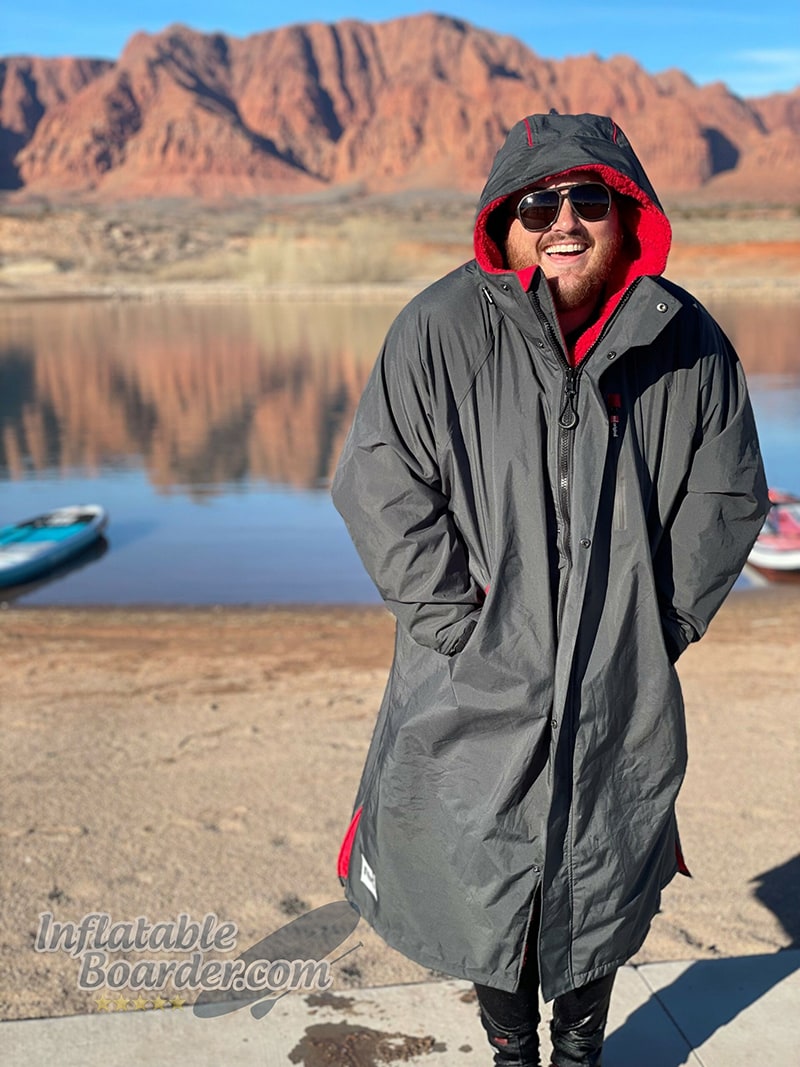
Falling into the water, even in a small protected pond, can be extremely dangerous. I look happy in this photo, but I can assure you I was extremely cold and shivering (early sign of hypothermia), and it was very difficult for me to swim the 20 yards back to shore after falling into this low 50’s F (about 10°C) water, even with 60°F (15° C) air temps.
Preventing Cold Shock
The National Center for Cold Water Safety proposes a few Golden Rules for paddling safely in cold water and preventing cold shock.
Wear a PFD – An inherently buoyant PFD will instantly help you float when in the water and can provide additional insulation in addition to your Cold Water clothing.
Dress for the Swim – Always dress for the water temperature and for the chance of complete immersion. It is far easier to cool yourself down while paddling than it is to fight against Cold Shock.
Test Your Equipment, Practice Self Rescue, and Acclimate – Make sure to test your equipment (clothing, PFD, etc.) in controlled situations (including swimming with your equipment), and practice your self-rescue techniques. The faster you can get out of the water, the better. As the seasons change, continue to paddle, and continue to test your equipment in the water (in safe conditions). The more your body is “used” to cold water, the better it will be at mitigating Cold Shock along with proper thermal protection, but this does not replace dressing properly.
Plan and Prepare for the Worst – You’re taking the first step by reading this guide. Understanding the risks of paddling in the winter and how to mitigate them is critically important. Prepare yourself and your crew with the right equipment and knowledge to stay safe year-round.
Paddle With a Group – This one I’ve added to the original list. Paddling with other people is not just a fun time, but adds a layer of safety with people that can help immediately in a bad situation. As an addendum to this, have each group member take time to practice rescue skills, take a first aid course, and be prepared for winter conditions.
Clothing for Winter Paddling
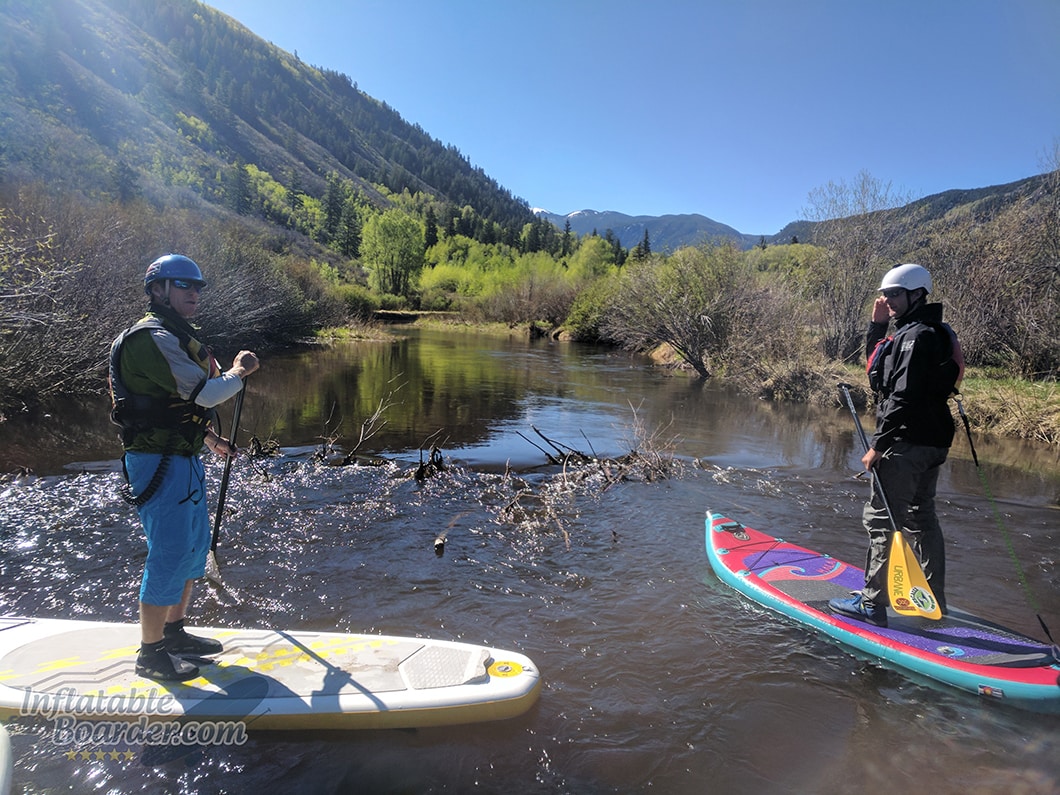
Sometimes it can be hard to decide what to wear during the spring and fall “shoulder” seasons. The paddler on the left is wearing neoprene and splash gear, the paddler on the right is wearing a dry suit. It’s a beautiful day, but how cold is that water…?
Now that you understand the additional risks of paddling in cold water and the general rules to mitigate those risks, let’s dive into what to wear while paddling in these colder seasons. Remember to always dress for the water temperature! It’s easier to cool down when paddling than it is to warm back up.
What Not to Wear
Let’s go ahead and take a few clothing options off the table when paddling in cold conditions.
First up is anything cotton. Cotton fabric absorbs water, becomes heavy, and has no insulating value when wet. If we were talking about great things to wear when paddling in extreme heat, cotton would be on the list, but in cold water and cold weather the phrase “Cotton Kills” should be remembered.
Waders. Waders may seem like a good idea at first. They are relatively inexpensive and easily accessible at most sporting goods stores, and keep your feet and legs dry when standing in the water or when splashed. The problem with waders is they have a gigantic hole at the top for you to step in to put them on. Even with a wading belt, waders are nowhere near water tight at the top of the garment, and even full-blown chest waders will be completely underwater if you fall off your board. Waders full of water do not help you stay warm, and they can make it almost impossible to get back on your paddleboard as you now must lift dozens of gallons of water with you to do so.
Wetsuits, Paddle Jackets, Semi-Dry Suits, and Dry Suits
Wetsuits are garments made of neoprene (or similar materials) of various thickness designed to fit snugly on the wearer in order to insulate the wearer while wet. Wetsuits work by essentially trapping a very thin layer of water within the neoprene material that your body warms up. The Neoprene and now-warmed water do an excellent job keeping you warm as long as the wetsuit is fitted snugly to your body to prevent new, cold water from moving in. Wetsuits must be fitted properly in order for them to effectively insulate you. Wetsuits that are too large or too long have large pockets and gaps that allow more water to move through the neoprene and make contact with your skin, greatly reducing their effectiveness. Neoprene tops and bottoms (like Hydroskins by NRS) work the same as a wetsuit, but are normally found only in lighter weights and do not offer quite as much thermal protection as a full wetsuit because they are split.
Shorty and Farmer John/Jane Wetsuits are wetsuits that are either short sleeved and short legged (shorties) or missing the arms and worn as overalls (Farmer John/Jane). These garments provide some thermal protection in cool waters (described below) but leave too much skin exposed to provide enough thermal protection to prevent cold shock in colder waters on their own. They can be paired with thinner wetsuits to provide extra thermal protection.
Paddle Jackets/Pants (aka “Splash Jackets/Pants”) are essentially rain gear designed for paddling. Though the materials they are made of may be waterproof, the garments are neither water-tight nor insulating. They provide no Cold Shock protection. While immersed, water moves freely through the garment. These garments are best used as windbreakers to keep you warmer in the air and keep you dry from splashing water or rain. They also work well to wear when you are back on your board or on land following immersion to help trap body heat.
Semi-Dry Suits and Garments are also made of waterproof materials (usually of a higher quality than “splash” wear) however they incorporate neoprene gaskets around their openings (at the waist and ankles for semi-dry pant;, at the waist, arms and neck for semi-dry tops; and at the arms, neck and feet for semi-dry suits). Provided they are fitted snugly, Semi-dry garments are able to keep water out of the garment for very short periods of time. They provide little insulation (though can be paired with insulating layers or neoprene garments) and should only be used by themselves in cool conditions above 60°F (15°C) water temperatures. Semi-dry suits often have either boot feet or latex ankle gaskets, latex wrist gaskets, and neoprene neck gaskets. A Semi-dry suit provides far better protection than a semi-dry top alone, however it is still not recommended for colder water or anything other calm conditions with quick self-rescue. Similar to waders, a semi-dry suit may fill with water if worn in the water for too long.
Dry Suits, Tops, and Pants are garments made of waterproof fabrics that completely encapsulate the wearer with a full set of latex gaskets. Latex gaskets are worn very snugly at the neck and wrists (some dry suits use them at the ankles instead of boot feet, but this is not recommended). While the dry suit itself offers little insulation, because they prevent any water from entering the suit, you can wear layers of warm, synthetic clothing to match the water temperature. This makes a dry suit one of the most versatile garments available for winter paddling. Dry suits are available in both men’s and women’s styles for better fit and convenient use of an appropriate “relief” zipper. There are “Dry Pants” and “Dry Tops.” These garments are a little bit of a misnomer. While dry tops will have latex neck and wrist gaskets, they will only have a neoprene or nylon waist. Dry pants may have latex ankle gaskets or waterproof boot feet, but again only a neoprene or nylon waist. Like semi-dry garments, dry tops and dry pants will prevent water entry for short periods of time, but not prolonged periods of time. Some dry pants and dry tops are designed to interlace with each other at the waist and provide a better water barrier than the top or pants alone, though they should not be relied upon if there is a chance for long periods of time in the water. These dry garments are great for the spring and fall – cool water – seasons, but not for colder water.
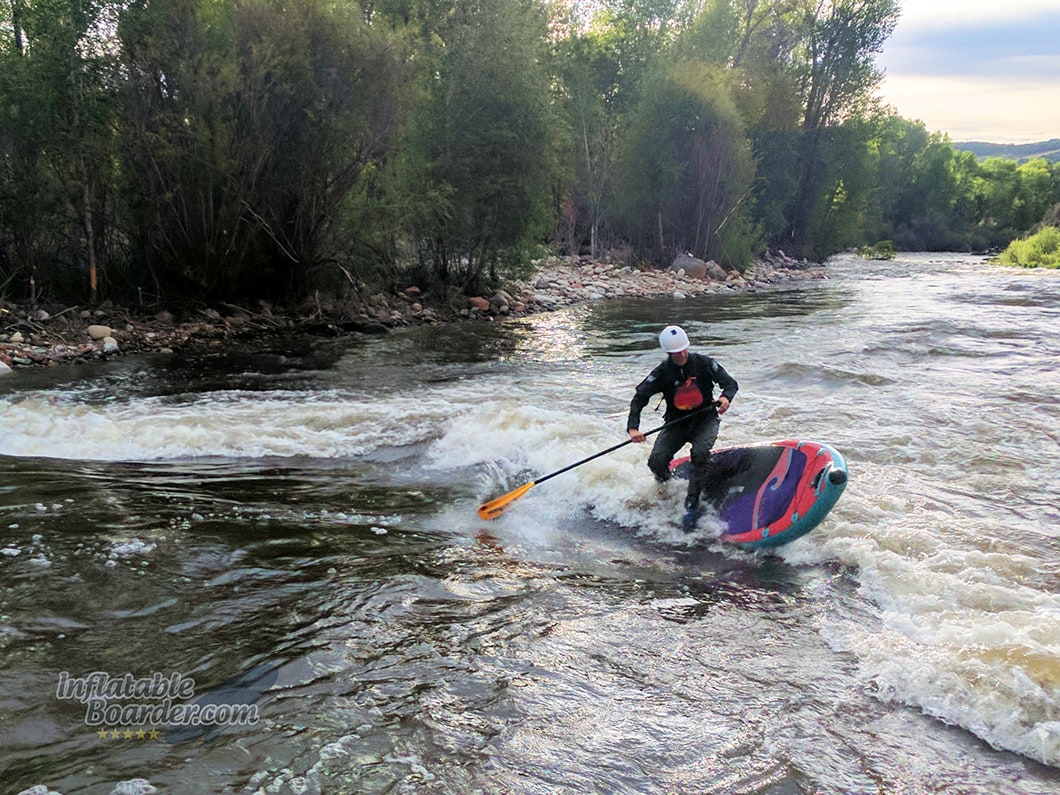
A full dry suit offers immersion protection, even in turbulent water, and can be layered underneath with warm clothing to match water temperatures.
>75°F (24°C) Water Temperature – What to Wear
In this pleasant-to-slightly cool temperature range paddlers will feel most comfortable dressing as they would for air temperatures of the same. Basic quick-dry synthetic clothing is usually enough to stay comfortable and the risk of Cold Shock is essentially non-existent (however in very hot climates the temperature difference between the air and water may trigger some gasping response in overheated individuals).
Recommended clothing:
- Quick-dry wicking shirts (short or long sleeve)
- Quick-dry wicking shorts or swim suits
- A light layer, towel and change of clothing in a dry bag to have if needed
60°-75°F (15°-24°C) Water Temperature – What to Wear
Competition swimming pools will be between around 75°-77° (24°-25°C) on the low end, and temperatures below this will feel cool and approaching quite cold to most people. Synthetic clothing alone will not provide adequate insulation and comfort in these temperatures. Wetsuits and other Neoprene garments are recommended for these temperatures. Farmer John/Jane and “Shorty” wetsuits may be acceptable for the higher end of this water temperature range, but not for the lower end as they leave significant portions of your body exposed to the water.
Recommended clothing:
- 1.0-3.0mm Neoprene clothing
- Semi-dry suits and garments
- Neoprene socks or booties
- Neoprene gloves or pogies
- A towel and change of clothing with a jacket in a dry bag to have if needed
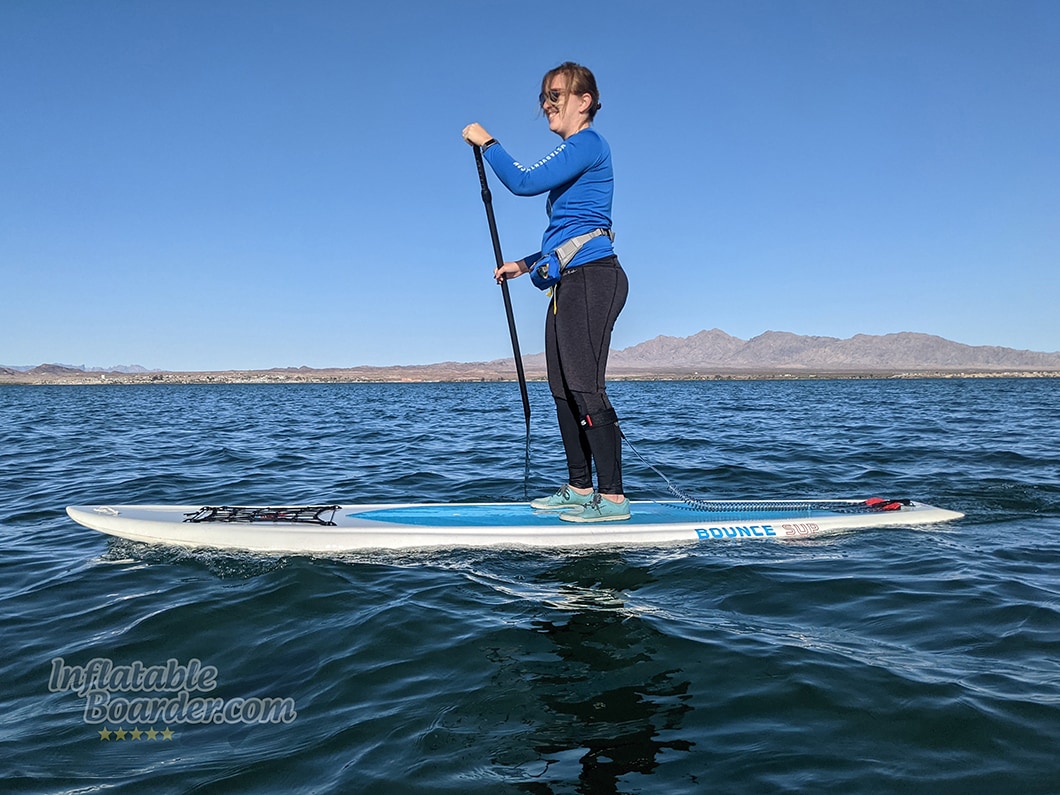
Thinner wetsuits or neoprene separates are great for early fall when water temperatures are still above 60°F (15°C).
50°-60°F (10°-15°C) Water Temperature – What to Wear
This temperature range has the highest rate and maximum potential intensity of Cold Shock and should be taken very seriously. Water in this temperature range is very cold, but can also be found when air temperatures and surface conditions are otherwise considered pleasant. Remember, it’s easy to cool yourself down with some gentle splashing or sitting on your board with your feet over the sides if you do become warm.
Recommended clothing:
- 3-5mm neoprene Wetsuits or a Dry Suit
- Semi-dry suits may be acceptable at the upper temperature range in calm conditions
- Thicker neoprene socks or booties
- Neoprene gloves
- Neoprene hood or cowl
- A towel, heavy change of clothing and jacket in a dry bag along with chemical warming devices
<50°F (10°C) Water Temperature - What to Wear
Water this cold is painful and can feel like your skin is on fire. Thicker wetsuits are one option, however a full dry suit with all latex gaskets and boot feet (latex or waterproof fabric) is highly recommended. Dry suits will keep all but your hands and head dry, and if layered properly, warm.
Recommended clothing:
- Full Dry Suit or 5-7mm wetsuit with hood
- Synthetic insulating clothing to wear under the dry suit
- Warm socks to wear under the dry suit
- Water shoes or booties sized up to wear over your dry suit
- Neoprene Gloves
- Neoprene hood or cowl
- A towel, heavy change of clothing and jacket in a dry bag along with chemical warming devices
<40°F (5°C) Water Temperature - What to Wear
Extremely cold water temperatures should only be paddled in a full dry suit with heavy insulation.
Recommended clothing:
- Full Dry Suit
- Heavy synthetic insulating clothing to wear under the dry suit
- Water shoes or booties sized up to wear over your dry suit
- Thick neoprene gloves or mittens
- Thick neoprene hood or cowl
- A towel, heavy change of clothing and jacket in a dry bag along with chemical warming devices
Other Equipment and Tips for Winter Paddling
With the right set of clothing you can be ready for even the coldest conditions, but clothing isn’t the only thing you need for fun and safe paddleboarding during the winter.
Wear a PFD!
Personal Flotation Devices, also known as PFDs, Life Jackets, or Buoyancy Aids, are often required to be with you while stand up paddleboarding, but are not always required to be worn. The problem with this lax requirement is that PFDs are like seatbelts – when you need it it’s too late to put it on. This is especially true in cold water where you can have the total loss of fine motor control in seconds. According to the US Coast Guard boating statistics for 2021, 83% of all boating fatalities included not wearing a life jacket as a primary contributing cause of drowning.
Always wear your PFD – especially when paddling in cold water.
There are many types of PFDs, and some are more appropriate than others for winter paddling. In the summer I love wearing my inflatable belt pack Type V PFD. It meets all of my local regulations and is almost completely unnoticeable while paddling. If I find myself in a situation where I need additional flotation (like getting separated from my SUP) I can pull a cord and have 22 lbs of buoyancy in about a second. However, Inflatable PFDs are not an appropriate choice for cold water paddleboarding. Even auto-inflating PFDs should be swapped for inherently buoyant types. In cold water, even a single second counts to help keep your head above water and out of trouble. Most belt-style inflatable PFDs also require you to manipulate a strap or the flotation aid itself around your head and/or torso to provide adequate flotation. This may not be possible to do at all if you are dealing with Cold Shock.
There are many types of inherently buoyant PFDs, and depending where you are they may go by different official names. The USCG uses the “Type” system (Type I, II, III, IV and V) to denote different uses and flotation requirements. In the EU there are various types of PFDs set up for various uses and indicated by their load-bearing capacity in Newtons (50N,70N, 100N, 150N, and 275N) and for their use. It’s important to note that 50N Buoyancy/Swim Aids are NOT life jackets/PFDs and should not be used for boating. Unfortunately these two systems of classification don’t share much in common to make a comparison between the categories.
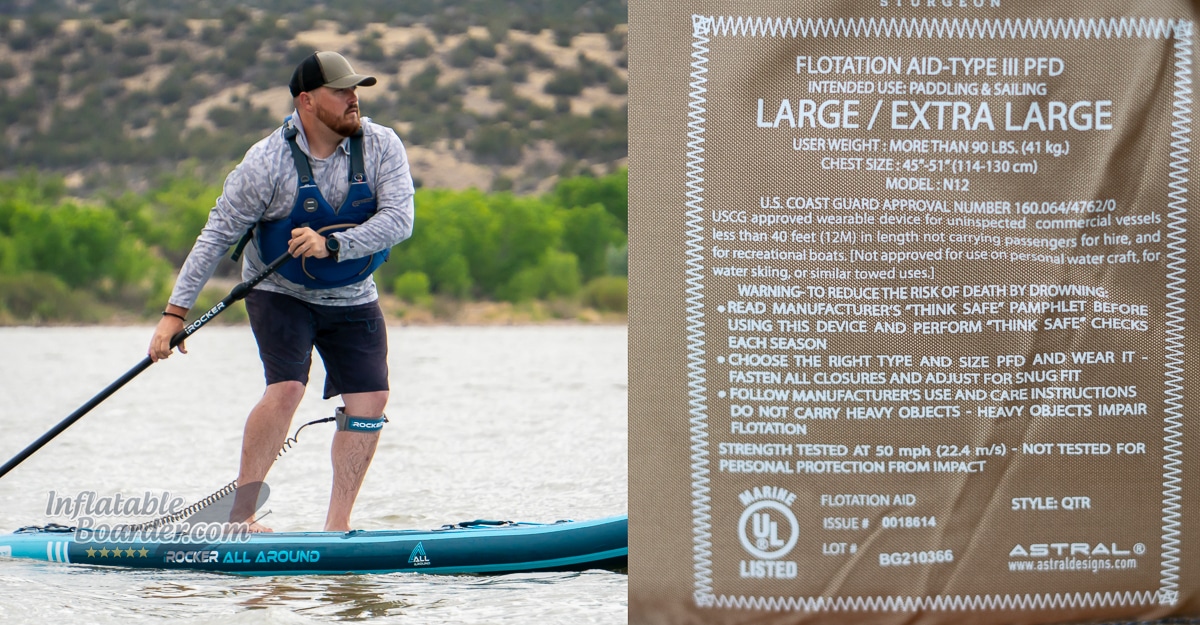
A PFD made for paddling will have very large arm holes for maximum range of motion. The information panel on a USCG-approved PFD will list the type (“Type III”), intended use (“Paddling & Sailing”), sizing information and USCG approval number, plus additional safety and use information.
For the purposes of Stand Up Paddleboarding and other recreational paddling, all paddlers should be wearing a properly-fitted USCG Type III PFD* or EU/ISO 70N Life Jacket. These devices are then further subdivided into designs intended for specific use. We want to make sure we are using devices designed for paddlesports rather than motorsports/personal watercraft. You can find this information printed clearly on the inside of the PFD. If the PFD you have or are looking at does not clearly indicate its Type/Classification, intended use, and expiration date (PFDs do expire!) then do not use it! Not only will it not keep you safe, but you may end up with a citation if checked for compliance.
*Some USCG Type V PFDs are also considered Type III because of their use – an example are PFDs used for whitewater that include integrated quick-release harnesses for rescue.
In addition to offering instant buoyancy while in the water, a properly fitted PFD will also help insulate your core against hypothermia – but should never be counted on as thermal protection for Cold Shock.
Get Warm and Stay Warm
It wouldn’t be winter paddling if it weren’t cold outside! So how can we stay warm or warm back up if we start to get chilled?
Dress for the occasion. Always dress for the water temperature. Keep in mind that over-dressing is always better than under-dressing (and it helps keep you warmer in colder air temperatures as well).
Dress for circulation. Dressing in layers can definitely help keep you warm, but you need to make sure you are sizing your layers appropriately as well. Layers that are too tight put pressure on your skin and outer blood vessels and can lead to making you feel colder. The same goes for any shoes that you are wearing. Lace them tight enough to stay on, but loose enough to allow for proper blood flow.
Keep your tank full. Your body produces its own heat through various metabolic processes, so keep your personal fuel tank full by eating a hearty meal with both quick- and slow-burning foods. Carbohydrates for quick energy and protein and fat for long-term energy. The same goes for snacks. Having a few high-quality snacks with you can help keep your energy and warmth up.
Stay Hydrated. Your body needs water. We are about 70% water by mass to begin with, so keeping ourselves hydrated makes it easier for our body to stay warm. Don’t be afraid to use warm drinks as well. In addition to drinking water, warm tea, coffee, or even hot cocoa from a thermos can help warm you up quickly and keep you hydrated. Yes, caffeine is a diuretic, but drinking a cup of coffee will still hydrate you more than it dehydrates you – just be ready to take a break to use the facilities after your morning cuppa.
Keep moving. Movement increases blood circulation which increases warmth in our extremities. Paddling your SUP is a great way to generate some heat in your arms and legs. It’s important to also keep your feet and hands moving as well to improve circulation all the way to your toes and fingers. Heel lifts and wiggling your toes will reduce tension in your feet and improve circulation.
Chemical Hand Warmers are small pouches of a few different materials that begin to warm up when exposed to oxygen. By opening the package and shaking the hand warmers they will begin to warm up within just a few minutes. These are great to keep in a pocket or even put them in your dry suit to add a little bit of extra warmth from an external source for up to 6-8 hours. However, once the hand warmers get wet they stop producing heat, so make sure to keep them in a dry place.
Check Your Pressure
Paddling in the cold, especially in cold water, can change the pressure inside your iSUP. If you use an electric pump to inflate your board, this is especially true. While you are inflating your board, the air inside is at the same temperature, or warmer, than the air temperature. Once you put your board on the water, the air inside will begin to cool down. As air cools, it contracts and reduces the interior pressure. While dropping from 20 PSI to 17 PSI may not make a hugely noticeable difference in stiffness, dropping from 15 PSI to 12 PSI will.
Once you inflate your board, set it in the water and let it sit for a few minutes to “temper” it to the water temperature. Then take the board out and re-inflate it to your desired pressure. This will help keep the pressure in the board correct as you paddle. The same goes for overnight trips. If the ambient temperature drops significantly overnight, your iSUP may be at a significantly lower pressure than what it started with. Less pressure tends to make a paddleboard less stiff, which makes it less stable, which increases the chance of falling into the water.
Paddle With a Group and Paddle With a Plan
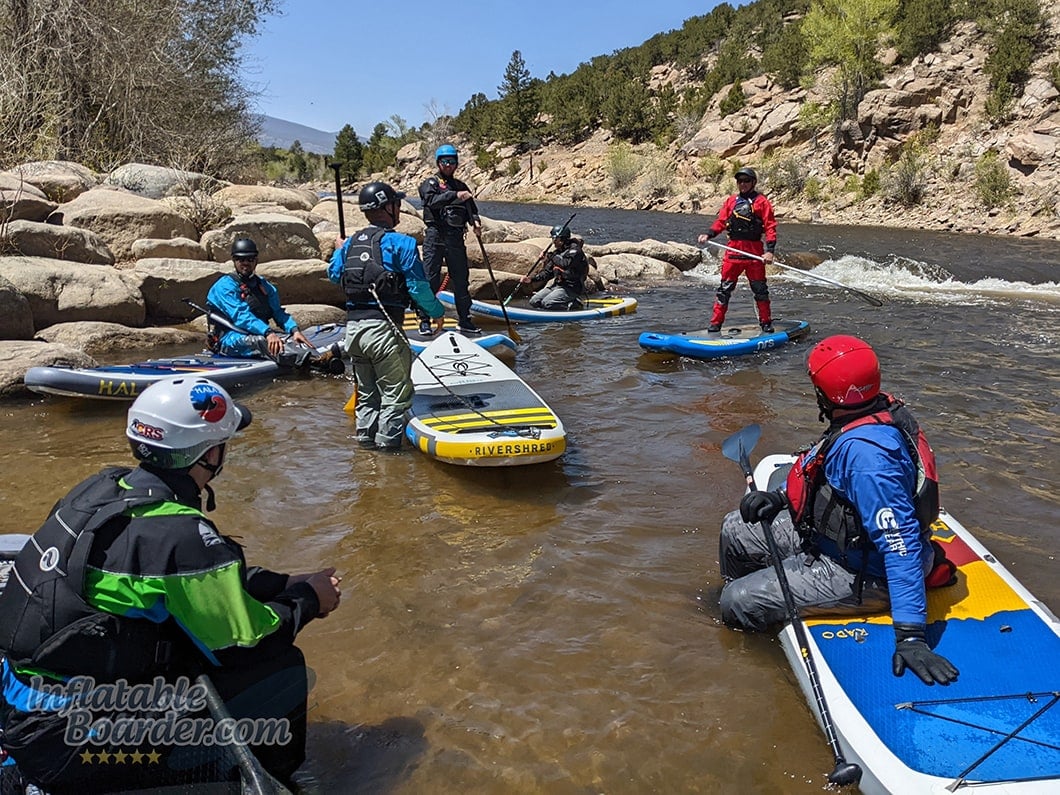
There’s safety in numbers. Whether you are paddling whitewater or just cruising your local lake, a paddling partner or two can be an extremely valuable safety net!
These tips can be used any time of year (and I do recommend it), but it’s particularly important in the winter. Paddling with a group of people provides a great safety net in case anyone does fall in. Another paddler can make it much easier and faster to get back on your board. In an emergency situation having people around to help, and go get help, is extremely valuable in the chain of survival. Having other paddlers around can also make it easier to keep an eye on your surroundings. Other watercraft, changes in weather, or even hazards in the water can be identified faster with more people.
Even when paddling with a group, it’s best to tell someone who is staying on land what you are going to be up to. The official term for this is a “Float Plan” but it needn’t be that detailed. The important information your home-base partner needs is:
- Where you are going
- Who you are going with/how many paddlers
- When you are starting
- Where you are finishing (if different from where you started)
- When you expect to be finished – and what time you will check in to verify you are off the water
- Phone numbers for local emergency help if you do not check in on time (this may be the general emergency phone number, a park ranger station, USCG/RNLI/etc station, or other number)
This may seem like a lot of information, but it’s all extremely useful in case something does happen.
Keep Extra Layers Handy (and Dry)
Sometimes the weather changes, and sometimes we just want to feel a little warmer than we are. Having extra layers on hand is a quick and easy way to add insulation while paddling. Synthetic-insulation jackets, fleece clothing, gloves and hats are all great to have available to layer under a dry suit or over a wetsuit if needed. I like to keep a towel, an entire change of clothes, and an extra layer or two in a dry bag while winter paddling. If I do get wet and I am having difficulty getting warm again, stopping, drying off, and changing into dry clothes is really helpful to warm back up.
Carry an Emergency Kit and Get First Aid/CPR Certified>
An emergency kit will vary based on where you are going, for how long, and the conditions. Your emergency kit should be kept in a dry bag and easily available.
A few items to keep in your emergency kit are:
- Chemical hand warmers
- Towel and change of clothes/warm layers
- Small first aid kit, including a pocket CPR face shield
- Communications device appropriate for the area (phone, VHF radio, and/or satellite communications device)
- Headlamp flashlight
- Pealess whistle
If you will be venturing out into the wilderness, your kit should expand to include a more robust first aid kit, fire starting materials, some calorie-dense food, and a satellite communications device.
First Aid and CPR certification are useful skills to have whether you are paddling, driving, at work, or anywhere else. When paddling in cold conditions being able to identify and treat hypothermia in its early stages is very important. Moderate to severe hypothermia can cause loss of balance and confusion (both dangerous while on the water), and is much more difficult to treat.
Aprés Paddle
After you are done enjoying a winter paddle, there are a few things that can help you warm up and stay warm for your trip home.
Get Dry – just like how being in the water makes you colder faster, being wet does the same. Getting dry is the first step to warming up after a fun day on the water.
Changing Robes are a great way to stay warm and covered while changing out of your paddling clothes into regular clothes. Nixy has an awesome Waterproof Changing Parka that is waterproof, wind proof, hooded, and insulated with soft, fluffy fleece. The double zipper and very generous sizing makes it easy to adjust the parka to get dressed. It’s hooded with the same warm fleece lining and waterproof/windproof shell material, and it has several large zippered pockets that can easily fit phones, keys, chapstick and more.
Cozy Clothes – obviously you’ll want something to change into while using your changing robe. I like to leave a full set of super comfortable and warm fleece clothing in my car while I paddle. And don’t forget some warm wool socks!
Warm Drinks are always welcome after a day out on the water. A high-quality thermos like the Stanley vacuum sealed thermos will keep your beverages hot all day while you are paddling.
Equipment Care in Cold Weather
When it’s cold, and the water is cold, and you are cold, taking care of your equipment can seem more of a burden than normal. When you want to get inside and warm up the desire to move quickly is strong, but taking care of your equipment is still a really important part of your paddle session. There are a few tips and shortcuts I’m going to share with you, but some things are still best done at the waterfront.
Clean Your Gear. It’s easiest to remove dirt, mud, and salt water right away rather than letting it sit on your board. If you have access to a freshwater source (or you are paddling on fresh water) take a few minutes right when you finish paddling to make sure your board, fin(s), paddle, and leash are all clean. I like to keep a 2 gallon garden sprayer full of fresh water in my car to clean off my equipment.
Dry Your Gear. This one can actually be difficult when it’s cold outside as water doesn’t like to evaporate as fast and drying by hand may take lots of towels (and cold hands). Here’s a trick for you: let your board and gear dry as much as possible while you get changed/ready to go. If you are driving and have the room in your trunk, back of the van, or truck bed, roll your board up loosely and put it there for the drive – even if it’s not dry. If you are getting a ride, walking/biking, or taking public transportation, go ahead and put it all back in the bag while it’s wet. But don’t leave it that way! As soon as you get home, take your gear into your bathroom and put it in the bathtub or shower. Now you can let it air dry and easily wipe it down with some towels to finish drying. Make sure your bag is dry, too, before you pack it all away.
Don’t Store Your Board Cold. Between paddling sessions, don’t store your board outside or in un-heated/insulated areas. PVC becomes brittle when it is cold and unrolling and inflating a frozen iSUP can actually crack the PVC and cause leaking and tears. If your board is stored in a garage, storage unit, or other un-heated location, bring it inside for a full day before you plan to use it and let the PVC warm back up to room temperature. Your paddleboard will thank you.
Thanks for Reading!
Thank you so much for taking the time to learn about Winter Stand Up Paddleboarding. I enjoy paddling year-round and am often asked “what do I need to paddle in the fall and winter?” That is a big question and I’ve done my best to include everything I know, and everything I can research, in this guide about Winter Paddling. While much of this guide does focus on the dangers around cold water and winter paddling, I included that information to help you make the best decisions possible about enjoying the water all year. Much of my training as an instructor, guide, and outdoor enthusiast has been based around safety, and I’m always happy to share that information in hopes of making your time outdoors that much more safe and fun. I hope you find this information useful, and as always, please feel free to leave a question in the comments, or reach out to us using our contact form.
As always – have fun, and safe paddling.
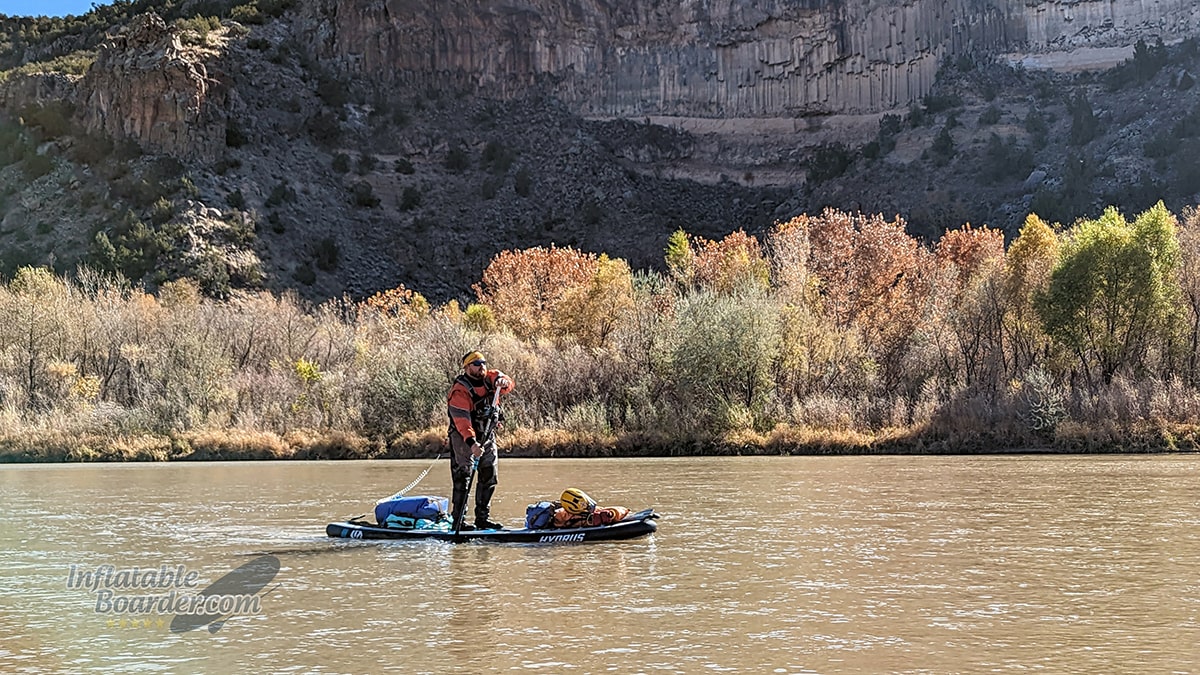
While on a winter overnight SUP camping trip I was comfortably warm in my dry suit even while paddling the Class II+/III rapids in 45° F (7° C) water and air temperatures during the day.

 1
1 

Shannon says
Fantastic post; thank you!